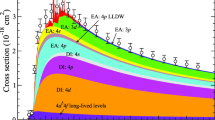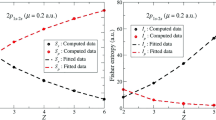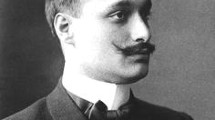Abstract
Neutral fragments of methane were performed using femetosecond laser at an intensity of 1013–14 W/cm2. A new mechanism of neutral dissociation is proposed in this work. The methane molecule is excited to super-excited states, in which it would dissociate into neutral fragments. We made Morse type potential energy surfaces for the super-excited molecules. Furthermore, we investigated the dissociation dynamics of the super-excited states by using quasi-classical trajectory (QCT) method. The results thus interpret the neutral dissociation of the methane molecule in the ultra-fast laser pulse.
Similar content being viewed by others
References
Chin S L. From multiphoton to tunnel ionization. In: Lin S H, Vil-laeys A A, Fujimura Y, eds. Advances in Multiphoton Processes and Spectroscopy. Singapore: World Scientific, 2004. 249–272
Tang X P, Wang S F, Elshakre M E, et al. The field-assisted stepwise dissociation of acetone in an intense femtosecond laser field. J Phys Chem A, 2003, 107: 13–18
Wang S F, Tang X P, Gao L R, et al. Dissociation of methane in intense laser fields. J Phys Chem A, 2003, 107: 6123–6129
Elshakre M E, Gao L R, Tang X P, et al. Dissociation of acetaldehyde in intense laser field: Coulomb explosion or field-assisted dissociation? J Chem Phys, 2003, 119: 5397–5405
Luo Q, Xu H L, Hosseini S A, et al. Remote sensing of pollutants using femtosecond laser pulse fluorescence spectroscopy. Appl Phys B, 2006, 82: 105–109
Xu H L, Daigle J F, Luo Q, et al. Femtosecond laser-induced nonlinear spectroscopy for remote sensing of methane. Appl Phys B, 2006, 82: 655–658
Gravel J F, Luo Q, Boudreau D, et al. Sensing of halocarbons using femtosecond laser-induced fluorescence. Anal Chem, 2004, 76: 4799–4805
Kong F A, Luo Q, Xu H L, et al. Explosive photodissociation of methane induced by ultrafast intense laser. J Chem Phys, 2006, 125: 133320
Furuya K, Ishikawa K, Ogawa T. Mass analysis of polyatomic high-Rydberg fragments produced by electron impact on methane. Chem Phys Lett, 2000, 319: 335–340
Kato M, Kameta K, Odagiri T, et al. Single-hole one-electron super-excited states and doubly excited states of methane in the vacuum ultraviolet range as studied by dispersed fluorescence spectroscopy. J Phys B: At Mol Opt Phys, 2002, 35: 4383–4400
Ma G, Suto M, Lee L C. Fluorescence from excitation of CH4, CH3OH and CH3SH by extreme vacuum ultraviolet radiation. J Quant Spectrosc Radiat Transfer, 1990, 44: 379–391
Worner H J, Qian X, Merkt F. Jahn-Teller effect in tetrahedral symmetry: Large-amplitude tunneling motion and rovibronic structure of CH −4 and CD +4 . J Chem Phys, 2007, 126: 144305
Demher P M, Chupka W A. High resolution study of photodissociation processes in O2. J Chem Phys, 1975, 62(11): 4525–4534
Rabalais J W, Bergmark T, Werme L O, et al. The Jahn-Teller effect in the electron spectrum of methane. Phys Scr, 1971, 3: 13–18
Ehresmann A, Liebel H, Schmoranzer H, et al. VUV-fluorescence spectroscopy of O2 photodissociation into neutral excited fragments between 17 and 19 eV. J Phys B: At Mol Opt Phys, 2004, 37: 389–401
Takeshita K. A theoretical analysis of Jahn-Teller effect in the photo-electron spetrum of methane. J Chem Phys, 1987, 86: 329–338
Pullen B P, Carlson T A, Moddeman W E, et al. Photoelectron spectra of methane, silane, Germane, methyl fluoride, difluoromethane, and trifluoromethane. J Chem Phys, 1970, 53: 768–782
Brundle C R, Robin M B, Basch H. Electronic energies and electronic structures of the fluoromethanes. J Chem Phys, 1970, 53: 2196–2213
Robin M B Higher Excited States of Polyatomic Molecules. New York and London: Academic Press, INC, 1974. 1, 108–120
Kassner Ch, Stuhl F, Luo M, et al. On the vacuum ultraviolet radical photolysis CH2(1 3B1) − hv-CH(A2†) − H(1 2S): A combined experimental and theoretical investigation. J Chem Phys, 1996, 105: 4605–4612
Bearda R A, Hemert M C, Dishoeck E F. Photodissociation of CH2. I. Potential energy surfaces of the dissociation into CH and H. J Chem Phys, 1992, 97: 8240–8249
Author information
Authors and Affiliations
Corresponding author
Additional information
Supported by the National Basic Research Program of China (Grant No. 2006CB806000)
About this article
Cite this article
Song, D., Liu, K., Kong, F. et al. Neutral dissociation of methane in the ultra-fast laser pulse. Chin. Sci. Bull. 53, 1946–1950 (2008). https://doi.org/10.1007/s11434-008-0232-6
Received:
Accepted:
Published:
Issue Date:
DOI: https://doi.org/10.1007/s11434-008-0232-6




